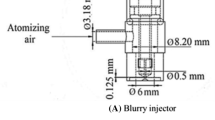Abstract
Combustion in high-preheat and low oxygen concentration atmosphere is one of the attractive measures to reduce nitric oxide emission as well as greenhouse gases from combustion devices, and it is expected to be a key technology for the industrial applications in heating devices and furnaces. Before proceeding to the practical applications, we need to elucidate combustion characteristics of non-premixed and premixed flames in high-preheat and low oxygen concentration conditions from scientific point of view. For the purpose, we have developed a special mixing nozzle to create a homogeneous mixture of fuel and air by rapid mixing, and applied this rapidmixing nozzle to a Bunsen-type burner to observe combustion characteristics of the rapid-mixture. As a result, the combustion of rapid-mixture exhibited the same flame structure and combustion characteristics as the perfectly prepared premixed flame, even though the mixing time of the rapid-mixing nozzle was extremely short as a few milliseconds. Therefore, the rapid-mixing nozzle in this paper can be used to create preheated premixed flames as far as the mixing time is shorter than the ignition delay time of the fuel.
Similar content being viewed by others
References
H. Tsuji, et al., High Temperature Air Combustion, CRC Press, (2002).
M. Katsuki and T. Hasegawa, The Science and Technology of Combustion in Highly Preheated Air, Proc. Combust. Inst. 27 (1998) 3135–3146.
P. R. Medwell, et al., Imaging of diluted turbulent ethylene flames stabilized on a Jet in Hot Coflow (JHC) burner, Combustion and Flame 152 (2008) 100–113.
T. Yokomori, et al., Electrostatic probe measurement in an industrial furnace for high-temperature air conditions, Combustion and Flame 150 (2007) 369–379.
C. Galletti, et al., Numerical and experimental investigation of a mild combustion burner, Combustion and Flame, 151 (2007) 649–664.
P. R. Medwell, et al., Simultaneous imaging of OH, formaldehyde, and temperature of turbulent nonpremixed jet flames in a heated and diluted coflow, Combustion and Flame 148 (2007) 48–61.
B. B. Dally, et al., Effect of fuel mixture on moderate and intense low oxygen dilution combustion, Combustion and Flame 137 (2004) 418–431.
H. Kobayashi, et al., Effects of Turbulence on Flame Structure and NOx Emission of Turbulent Jet Non-premixed flames in High-Temperature Air Combustion, JSME Int. J. 48B-2 (2005) 286–292.
J. H. Kwark, et al., Combustion Characteristics of a Turbulent Non-Premixed Flame using High Preheated Air, KSME Trans. 27(5) (2003) 561–568.
E. E. Khalil, et al., The Calculation of Local Flow Properties in Two-Dimensional Furnaces, Int. J. Heat Mass Transfer 18 (1975) 775–791.
S. V. Patankar, Numerical Heat Transfer and Fluid Flow, McGraw-Hill, (1980).
H. R. E. Van Maanen, et al., Improved Estimator for the Slotted Autocorrelation Function of Randomly Sampled LDA Data, Meas. Sci. Technol. 10 (1999) L4–L7.
L. H. Benedict, et al., Estimation of Turbulent Velocity Spectra from Laser Doppler Data, Meas. Sci. Technol. 11 (2000) 1089–1104.
M. Katsuki, et al., An Improved Thermocouple Technique for Measurement of Fluctuating Temperatures in Flames, Combustion and Flame 67 (1987) 27–36.
J. Furukawa, et al., Local Reaction Zone Configuration of High Intensity Turbulent Premixed Flames, Combust. Sci. Tech. 90 (1993) 267–280.
M. Katsuki, et al., Local Flame Structure and its Influence on Mixing Processes in Turbulent Premixed, Combustion and Flame 82 (1990) 93–105.
Author information
Authors and Affiliations
Corresponding author
Additional information
This paper was recommended for publication in revised form by Associate Editor Ohchae Kwon
Masashi Katsuki received his B.E. degree in Mechanical Engineering from Osaka University, Japan, in 1965. He received his Dr. Eng. from O. U. in 1985. Dr. Katsuki is currently a Visiting Professor at the Department of Environmental Engineering at Hoseo University in Chungnam, Korea. He was a Vice President of the Japan Society of Mechanical Engineers. Dr. Katsuki’s research interests include combustion, computational thermo-fluid dynamics, and molecular dynamics.
Jin-Do Chung received his B. S., M.S. and Ph.D. degrees in Mechanical Engineering from Chungnam University, Korea in 1983, 1985 and 1990. He then received another Ph.D. in Environmental Engineering from Kanazawa University, Japan in 1996. After that he worked as Post-doc researcher for 1,6 year at KIMM and Senior researcher for 6years at KEPCO Research Center. Dr. Chung is currently a Professor at the Department of Environmental Engineering at Hoseo University in Asan, Korea. Dr. Chung’s research interests include thermal-fluid and environmental engineering.
Jang-Woo Kim received his B. S. degree in Mechanical Engineering from Chungnam University, Korea, in 1990. He then received his M. S. and Ph. D. degrees from Kyushu University, Japan in 1994 and 1998, respectively. Dr. Kim is currently a Professor at the School of Display Engineering at Hoseo University in Asan, Korea. Dr. Kim’s research interests include CFD, aerodynamics, and display equipment technology.
Seung-Min Hwang received the Ph.D. degree in Mechanical Engineering at Osaka University in 2005. After that he worked as visiting researcher for 3 years at CRIEPI (central research institute of electric power industry) and Osaka University in Japan. He is currently a Professor at the Graduate School of Venture at Hoseo University in Korea. His major research is thermal-fluid, energy issue and environment.
Seung-Mo Kim received his Ph. D. degrees in Mechanical engineering from Osaka University, Japan, in 2004. Dr. Kim is currently a research Professor at Pusan Clean Coal Center at Pusan National University in Pusan, South Korea. Dr. Kim’s research interests include coal combustion, oxy-fuel combustion, coal gasification, coal de-watering, power generation plant system and energy issues.
Chul-Ju Ahn received his B.S. degree in Mechanical Engineering from Hanyang University, Korea, in 1998. He then received his M.S. and Ph.D. degrees from Osaka University, Japan, in 2001 and 2006, respectively. Dr. Ahn is currently a Senior Research Engineer at Samsung Techwin CO. LTD. in Changwon, Korea. Dr. Ahn’s research interests include gas turbine engine, biomass gasification, and power system.
Rights and permissions
About this article
Cite this article
Masashi, K., Jin-Do, C., Jang-Woo, K. et al. Development of rapid mixing fuel nozzle for premixed combustion. J Mech Sci Technol 23, 614–623 (2009). https://doi.org/10.1007/s12206-009-0201-2
Received:
Revised:
Accepted:
Published:
Issue Date:
DOI: https://doi.org/10.1007/s12206-009-0201-2




